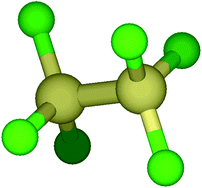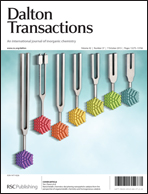Do QTAIM metrics correlate with the strength of heavy element–ligand bonds?†
Abstract
The bonding in monomeric and dimeric molecular compounds of Cr, Mo, W and U is explored using the Quantum Theory of Atoms-in-Molecules (QTAIM). The metal–ligand and metal–metal bond critical point properties ρb, ∇2ρb and Hb, and also the bond delocalisation indices δ(A, B), are correlated with the data from previous Ziegler–Rauk energy decomposition studies of the same systems. For M2X6 (M = Mo, W, U; X = Cl, F, OH, NH2, CH3), ρb, Hb and δ(A, B) display anticorrelations with the total interaction energy of the two MX3 fragments, implying that the weaker metal–metal bonds (those between two uranium atoms) are the more covalent ones. By contrast, strongly positive correlations are observed between the QTAIM parameters and the energy decomposition orbital mixing energies. This is also the case for metal–carbon, metal–nitrogen and metal–oxygen bonds in (CO)5M–imidazole tautomers (M = Cr, Mo, W) and uranyl phosphinimine and phosphine oxide compounds. These targets were chosen specifically because their energy decompositions feature negligible net electrostatic + Pauli “pre-relaxation” effects, and the QTAIM parameters correlate strongly with the orbital mixing-dominated total interaction energies. The metal–metal bonds in M2X6 are found to have significantly positive ∇2ρb (in agreement with many previous QTAIM studies of metal–metal bonding), and an anticorrelation is found between the total X3M–MX3 interaction energies and ∇2ρb. The positive ∇2ρb are traced to the dominant λ3 principal curvature, which correlates well with the destabilising electronic kinetic energy density at the bond critical points, providing a rationalisation of the anticorrelation between the total X3M–MX3 interaction energies and ∇2ρb.


 Please wait while we load your content...
Please wait while we load your content...